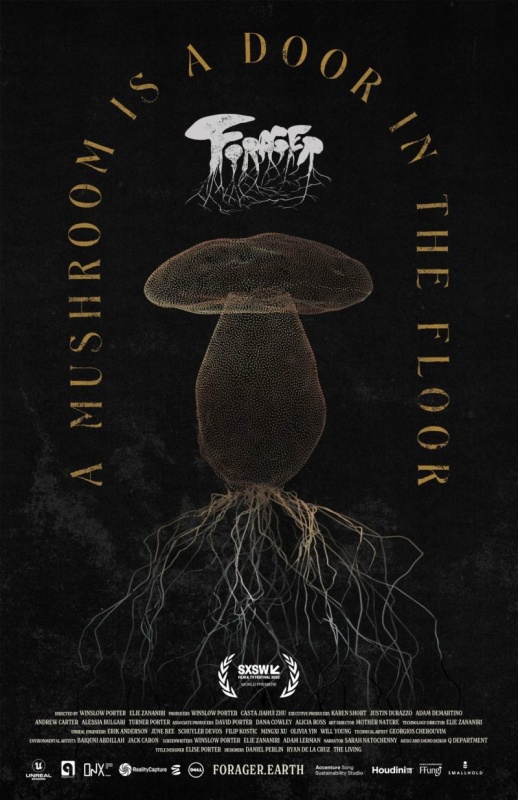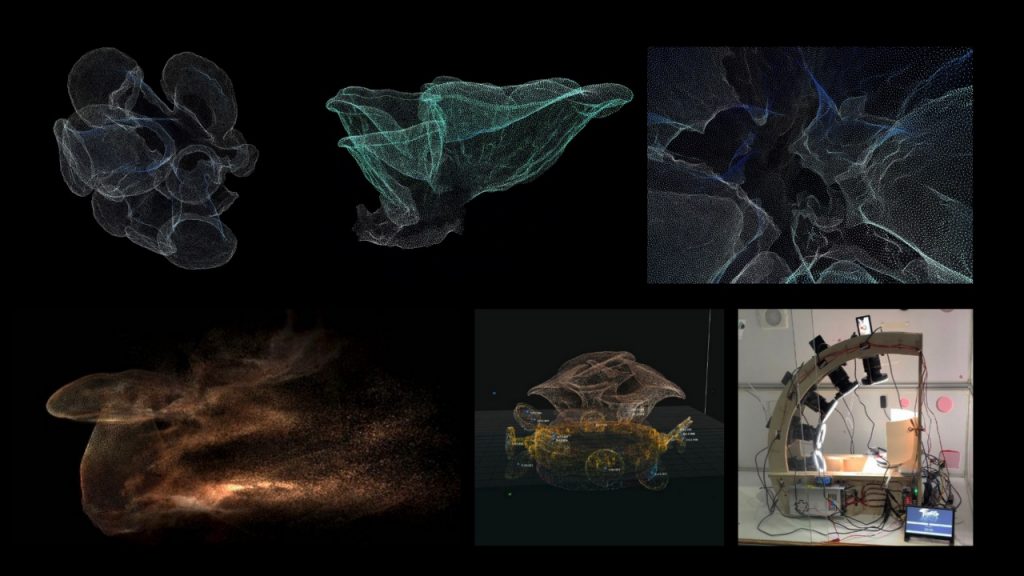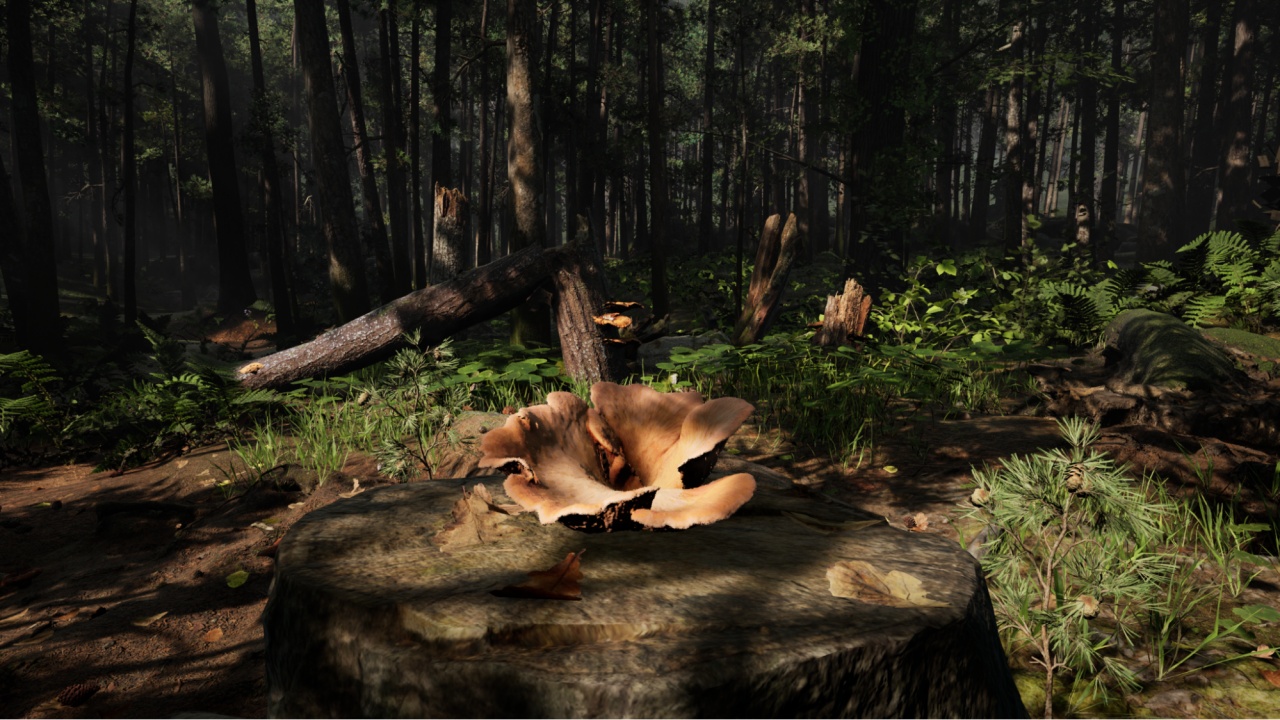As the first ever volumetric time-lapse inside of a game engine, FORAGER ( a 2023 SXSW selected experience) invented a new technological 3D process to tell the hidden story under our feet. In this immersive experience, the user lies down with a VR headset and embarks on a journey into nature from the perspective of a mushroom. Interview with creative director Winslow Porter, technical director Elie Zananiri, and executive producer Justin Durazzo.
Becoming a mushroom… in VR?
JD: The idea is to become a mushroom. I think a lot of people don’t know what mycelia are. They’re ancient. The fungi Kingdom is an ancient species that has survived five mass extinctions––dinosaurs, Chernobyl and has preceded human neurology. So it’s really interesting to look at the power of mushrooms and their role in nature. They’re this sort of secret mediator that’s living vastly underground like nature’s neurology.
WP: VR has a unique ability to place you in the shoes of the mycelium–– we’re able to view a mushroom on its own timescale. Humans are sort of myopic when we understand our place in this world. People don’t actually know that much about mushrooms and their life cycle. So, we’re trying to walk you through something often nebulous for people. We hope that this experience can shed light on it and ultimately inspire people to become more curious and understand about all the benefits that mushrooms provide.

EZ: I come from a tech background and we started this project to figure out how to do 3D stop motion––it’s something that a lot of people have thought about, but hasn’t really been done before. When we started with the 3D stop motion, we realized that a lot of people don’t do it because of all the steps involved. So from the start we needed to build something that was automated and ran itself.
A mushroom is a door in the floor. Open it, and discover an endless, underground network that feeds life-giving essentials to the plants above. Microscopic highways of mycelium a million miles long run beneath, hidden from our eye. And there, in the dark tunnels of the underground, this vast, invisible network performs nature’s alchemy, converting the many into one. An essential song that sustains all earthly life. Enter Forager and live the life of fungi, from air-borne spore to underground mycelium to sprouting mushroom. Bring the forest to life, and discover the magical world beneath your feet.
A self-evolving project
EZ: Every 30 minutes this photogrammetry rig captures a mushroom on its own. Those images get sent to a server that runs a piece of software called Reality Capture, who is one of our partners on the project, and spits out a 3D model. Every 30 minutes, one frame is captured. Every frame is 200 pictures. And, we probably have about a million or more pictures of mushrooms because we’ve been doing this for a while. Once we have all the models, we optimize them as a batch and then we create an animation out of that. So in the VR experience, what you’re seeing is the growing of a mushroom that we captured ourselves.

WP: Whenever we post pictures or videos of our mushrooms growing most of the creative code community thinks it’s procedurally generated, which to us is actually one of the biggest compliments. But in reality, it’s really hard to replicate nature. So we wanted to do something that we hadn’t seen other people do before.
EZ: We got excited because we saw mushrooms grow and they looked amazing. So, we wanted to stay true to that and use a photographic process and not a digital process or a simulated process. That’s why we’re trying to keep the shape as intact as possible and stay true to what Mother Nature has done.
Setting up a scenography for FORAGER
EZ: Originally, the idea was to walk around the mushroom and control its time scale with your movements. But that turned out to be really hard because people kept bumping into walls and as the mushroom got bigger, they didn’t really know how far they had to go. Then we started doing a seated experience, but that felt kind of traditional. Now, you lie down in the experience. It’s very comfortable, it’s very soothing, it’s very therapeutic. You go on this journey with the mushroom and following the whole lifecycle of the spore, to the Mycelium to the fruiting body, and back to the spores –following the whole lifecycle in a way where you can really focus on what you’re seeing, feeling, smelling, and hearing.

WP: We find that a lot of times that an experience is about learning an interface and seven minutes is a very short timeframe. Oftentimes people are just trying to understand their environment and what the participant’s journey is. We wanted to make that as easy for them as possible while also allowing them to have a different perspective. So even though you’re looking up, you can look forward and also look down. I think there’s a lot more to explore. Ultimately, mushrooms are really difficult to personify and we found that lying down was the most intuitive way for us to do that.
EZ: The main part of the mushroom is the mycelium. So underground it’s kind of like an iceberg. The mushroom really sprawls through the forest. It helps nature communicate. It sends nutrients back and forth and sends messages back and forth. So it’s a really big part of the story that a lot of people don’t know about because they just see the thing that they eat. We wanted to give that part of the mushroom a sense of ownership. To give you something to look at and understand and that you also are a part of it.
Virtual reality to explore the diversity of biology
JD: Looking back in history, whenever a new technology gives us access to science in ways that we haven’t had before, like electron microscopes looking at microorganisms, the James Webb telescope looking into the universe. The more data that we get, the better stories that we can tell.
JD: I think what Elie and Winslow are doing here with the volumetric photogrammetry is putting yet another eye to observe nature and using that as a provocation to tell more stories about our relationship to the fungi kingdom and to the world at large.



Leave a Reply
You must be logged in to post a comment.